Abstract
The human cytokines tumor necrosis factor (TNF) and granulocyte-macrophage colony-stimulating factor (GM-CSF) both promote growth and survival of malignant cells from children with juvenile myelomonocytic leukemia (JMML). It has been postulated that TNF stimulates GM-CSF gene expression in an autocrine manner. We found here that the specific inhibition of TNF gene expression by a catalytic RNA molecule (ribozyme) also downregulated the expression of GM-CSF in JMML cells. GM-CSF protein, GM-CSF–dependent colony formation, and viability of JMML cells were reduced. The observed effect was specific, because synthesis of interleukin-1β, another cytokine produced by JMML cells, was not affected by the ribozyme treatment. The stimulatory effect of TNF on GM-CSF gene expression in JMML cells probably takes place at the transcription level, because the ribozyme treatment decreased GM-CSF mRNA. No apparent toxicity of the ribozyme was detected in normal bone marrow progenitor cells. Thus, the inhibition of TNF gene expression in JMML cells by ribozymes may be a novel therapeutic approach for this disorder.
JUVENILE myelomonocytic leukemia (JMML), also named juvenile chronic myelogenous leukemia or childhood chronic myelomonocytic leukemia, is a myelodysplastic disorder affecting infants and small children.1,2 Although the exact diagnosis of JMML has been the subject of some controversy,2,3 all epidemiological studies have shown a low incidence.2,4 The aggressive nature of JMML is reflected in its resistance to chemotherapeutic treatment5,6 and the fact that a considerable number of patients relapse after bone marrow transplantation.7 8
The molecular mechanism underlying the pathogenesis of JMML is incompletely understood. JMML has been associated with neurofibromatosis type 1 (NF1).9 NF1 patients typically lack the NF1 tumor suppressor gene activity, thus possibly leading to malignant transformation and uncontrolled proliferation of myeloid cells as a consequence of a constitutive activation of the rasoncogene.10-12 Interestingly, the hemopoietic cytokine granulocyte-macrophage colony-stimulating factor (GM-CSF) stimulatesras activation.13 A growing body of evidence shows that GM-CSF is a stimulatory cytokine in JMML, because it both promotes JMML cell growth14-17 and inhibits apoptosis of JMML cells.18
Tumor necrosis factor α (TNFα) is another significant regulator in JMML. Anti-TNFα monoclonal antibodies (MoAbs) inhibit JMML cell growth,17,18 TNFα suppresses normal bone marrow hemopoiesis,17 and the immunomodulatory cytokine interleukin-10 (IL-10) downregulates both GM-CSF and TNFα synthesis in JMML cells, leading to a concomitant reduction in growth and viability of these cells.19 Moreover, immunodeficient mice engrafted with JMML cells produce high levels of human TNFα.20,21 Importantly, we recently demonstrated that, whereas a neutralizing human anti-TNFα MoAb did not affect the disease progress in immunodeficient mice engrafted with JMML cells and a human GM-CSF antagonist prevented dissemination of the disease, only a combined blockade of GM-CSF and TNFα eradicated the leukemic cells in the mice.21 Possibly there is an autocrine loop involving both TNFα and GM-CSF in JMML.17 To clarify this, we have now investigated the effect of an exogeneously delivered TNFα ribozyme on GM-CSF gene expression in JMML cells.
Ribozymes are RNA molecules with catalytic activity.22,23Recent experiments indicate that ribozymes can be designed to cleave in trans virtually any mRNA whose sequences are known.24-27However, despite this significant progress of ribozyme engineering, there is still a need to optimize ribozyme function in the complex intracellular environment. In the present study, we examined if an anti-TNFα ribozyme could be delivered to primary JMML cells and whether it could affect TNFα and GM-CSF gene expression and, hence, JMML cell growth and viability. Our data indicate that this novel strategy is amenable for studying the effect of TNFα on GM-CSF gene expression in JMML cells and suggest that treatment of JMML patients with ribozymes may be feasible.
MATERIALS AND METHODS
Donors and Cells
This investigation was approved by ethics committees, and parental consent was given to study bone marrow samples collected from 3 children aged 1 to 4 with diagnosed JMML according to criteria defined by the International Juvenile Myelomonocytic Leukemia Working Group.2 Bone marrow cells from a healthy child (2 years) were used as a control.
Mononuclear cells were prepared from bone marrow by dextran sedimentation of erythrocytes and using density centrifugation as previously described.18 More than 99% of these isolated cells from the JMML patients and about 50% of the cells from the healthy child expressed surface receptors for GM-CSF and TNFα, as detected with MoAbs and flow cytometry (data not shown).
The Anti-TNFα Ribozyme
Ribozyme synthesis.
A double hammerhead ribozyme (Rzd) having as cleavage sites a CUC and a GUC corresponding to the codon for leu −60 and val +1, respectively, within human TNFα mRNA was synthesized by in vitro transcription using DNA oligodeoxynucleotide and the T7 RNA polymerase as described previously.26 Briefly, two overlapping half deoxynucleotides containing the T7 promoter sequence and the sequence coding for the ribozyme minigene were hybridized and then extented with the Klenow fragment of DNA polymerase. After extension, the DNA was gel-purified and then used as template for in vitro transcription. The sequences of the overlapping primers are as follows: primer 1: 5′-TAATACGACTCACTATAGAAGATGATCTCTGATGAGTCCGTGAGGACGAAACTGCCTGGGCAAAAA-3′; primer 2: 5′-TGGAGGCGCTTTCGTCCTCACGGACTCATCAGCCCAATTTTTGCCCAGGC-3′.
The sequence of the double ribozyme Rzd is as follows: 5′-GAAGAUGAUCUCUGAUGAGUCCGUGAGGACgAAACUGCCUGGGCAAAAACUUCUUGGGCUGAUGAGUCCGUGAGGACgAAAGCGCCUCCUC-3′. The hammerhead core sequence is underlined, and bold letters correspond to an adenosine linker. A noncleaving hammerhead ribozyme (Rzdm) was made by deleting the G12 from the catalytic core of the ribozyme as indicated by the lower case letter. The in vitro-transcribed ribozymes Rzd and Rzdm were gel-purified and their concentrations were estimated by measurement of absorbency at 260 nm.
RNA substrates.
The 23 nucleotide (nt) target RNA (5′-GCCCAGGCAGUCAGAUCAUCUUC-3′) corresponding to the ribozyme site b (Fig 1A) was synthesized by in vitro transcription using the following deoxynucleotides: deoxynucleotide I: 5′-GAAGATGATCTGACTGCCTGGGCTATAGTGAGTCGTATTA-3′; deoxynucleotide II (T7 promoter): 5′-TAATACGACTCACTATAG-3′.
(A) Schematic diagram of the ribozyme Rzd cleavage sites and cleavage products. The closed arrows show the two sites of cleavage (a and b), whereas the open arrow indicates the end of the translated region (leu 157). (B) Cleavage of the 732 nt target TNF RNA with (+) or without (−) ribozyme Rzd. The data represent the PhosphorImager printout of 8% denaturing polyacrylamide gel. The arrows starting from the top indicate the cleavage fragments no. 1, 3, and 2 depicted in (A), respectively.
(A) Schematic diagram of the ribozyme Rzd cleavage sites and cleavage products. The closed arrows show the two sites of cleavage (a and b), whereas the open arrow indicates the end of the translated region (leu 157). (B) Cleavage of the 732 nt target TNF RNA with (+) or without (−) ribozyme Rzd. The data represent the PhosphorImager printout of 8% denaturing polyacrylamide gel. The arrows starting from the top indicate the cleavage fragments no. 1, 3, and 2 depicted in (A), respectively.
The 732 nt target RNA was synthesized by in vitro transcription using a polymerase chain reaction (PCR)-amplified cDNA as template. Briefly, total RNA prepared from endotoxin-stimulated (100 ng/mL) peripheral blood mononuclear cells was reverse transcribed using a TNFα specific primer (5′-TCGCCACTGAATAGTAGGGCGATTA-3′). The cDNA was PCR-amplified using a second primer specific for TNFα and containing at its 5′ end the T7 promoter top strand (5′-TAATACGACTCACTATAGATGAGCACTGAAGCATG-3′). The expected amplified product (749 bp, including the T7 promoter sequence) was purified and in vitro-transcribed using the T7 RNA polymerase. The in vitro-transcribed 23 nt RNA substrate was gel-purified and dephosphorylated, and the 5′ end was labeled using [γ-32P]ATP and polynucleotide kinase. The 732 nt substrate was internally labeled with [α-32P]ATP during in vitro transcription.
In vitro hammerhead ribozyme cleavage activity.
Cleavage reactions were performed at 37°C in buffer containing 50 mmol/L Tris-HCl (pH 7.4) and 10 mmol/L MgCl2 for 1 hour. Cleavage products were separated by electrophoresis on an 8% polyacrylamide gel containing 7 mol/L urea and visualized by a PhosphorImager (Molecular Dynamics, Sunnyvale, CA).
Transfection experiments.
The cells were transfected with cationic liposomes (DOTAP; Boehringer Mannheim, Mannheim, Germany) at a concentration of 25 μg/mL either alone or complexed with the test molecules as described previously.27 To study the kinetics of uptake of our ribozyme into the JMML cells, we transfected cells simultaneously with two batches of liposomes: some containing the ribozyme Rzd and some containing an irrelevant oligonucleotide 5′ labeled with fluorescein. The concentration of the oligonucleotide versus the ribozyme was 1 to 5. The uptake rate into these cells was analyzed with flow cytometry (FACScan; Becton Dickinson, Mountain View, CA).
Colony Assay, Determination of Cell Viability, and Cytokine Production
Cells from the JMML patients or the healthy child (105cells per plate) were cultured for 2 weeks either in methylcellulose or agar.18 The cells were incubated in liquid culture (RPMI medium) with liposomes containing the desired oligonucleotide for approximately 10 to 15 hours before they were plated. Colonies (>40 cells) were then scored, plucked, and stained supravitally.28
To examine cell viability, JMML cells or normal bone marrow progenitor cells were grown in liquid culture for specified times before they were stained with propidium iodide and analyzed with flow cytometry.18
From the liquid cell cultures we collected samples to measure the protein concentrations of GM-CSF, TNFα, and IL-1β using specific enzyme-linked immunosorbent assay (ELISA) kits (sensitivity, >0.5 pg/mL; R&D Systems, Minneapolis, MN).
We also measured the mRNA for GM-CSF, TNFα, and granulocyte colony-stimulating factor (G-CSF) in cells from the liquid cultures and using an RNAse protection assay.29 Gels were quantified with a PhosphorImager. Values are expressed relative to the GAPDH signal, with corrections made to incorporate different specific activities of the probes.
Recovery of the Ribozyme Rzd From Agar Sectors
We added 400 μL TE buffer and 400 μL phenol:chloroform:isoamyl alcohol mixture to each agar sector. Samples were shaken vigorously and then spun for 10 minutes at 4°C. The top aqueous phase was carefully removed, 40 μL of 3 mol/L sodium acetate (pH 7.0) was added, and then the RNA was precipitated by 2.5 vol of ethanol at −70°C for 12 hours. After precipitation and washing with 70% ethanol, each RNA pellet was dissolved into 10 μL water and then tested for cleavage.
RESULTS
In Vitro Cleavage of Ribozyme Rzd
A ribozyme (Rzd) directed to site a and b, as shown in Fig 1A, was synthesized by in vitro transcription, and its in vitro cleavage activity was determined using the 732 nt target TNFα mRNA. Because the ribozyme is directed to two different sites, cleavage at site a and/or site b should generate 5 different cleavage fragments. To visualize the smallest fragments, numbered as 1, 2, and 3, the cleavage products were analyzed by 8% denaturating polyacrylamide gel. Figure 1B shows that the ribozyme Rzd cleaved the in vitro-transcribed target RNA at the expected sites. The cleavage products with high molecular weights were not separated from the target RNA in our electrophoresis conditions.
Ribozyme Uptake by JMML Cells and Diffusion Within the Agar Plate
To determine the uptake rate of the ribozyme Rzd into JMML cells, we simultaneously transfected the cells with two batches of liposomes, one containing Rzd (1 μmol/L) and one with an irrelevant oligonucleotide (0.2 μmol/L) labeled with a fluorescent molecule, and then we analyzed the samples with flow cytometry. Figure 2 shows that, by 12 hours, almost all the cells had taken up the fluorescent oligonucleotide, and it remained with the cells throughout a 72-hour period during which we did our measurements.
Ribozyme uptake kinetics in JMML cells. The cells were transfected with two types of liposomes, one containing the ribozyme Rzd (1 μmol/L) and one containing a 20-nucleotide fluorescein-labeled oligonucleotide (0.2 μmol/L). Samples were taken at various time points and cell-associated fluorescence was analyzed with flow cytometry. Values are the means ± SEM from triplicate measurements of JMML cells taken from 1 patient and representative of the 2 other patients.
Ribozyme uptake kinetics in JMML cells. The cells were transfected with two types of liposomes, one containing the ribozyme Rzd (1 μmol/L) and one containing a 20-nucleotide fluorescein-labeled oligonucleotide (0.2 μmol/L). Samples were taken at various time points and cell-associated fluorescence was analyzed with flow cytometry. Values are the means ± SEM from triplicate measurements of JMML cells taken from 1 patient and representative of the 2 other patients.
In the next set of experiments, we have analyzed the diffusion of the cationic liposomes containing Rzd within different sectors of an agar plate after 2 weeks of incubation with JMML cells (Fig 3A). Five agar sectors were excised from the plate, and the Rzd from each agar sector was extracted. Half of the recovered material from each sector was assayed for cleavage using a short substrate corresponding only to site b. It is evident from Fig 3B that significant and comparable amounts of cleavage activity were recovered from all sectors, suggesting a homogeneous distribution of the ribozyme Rzd within the entire agar plate.
(A) Schematic diagram of a wedge of an agar plate. Sector 1 represents the center, whereas sector 5 represents the periphery of the plate. (B) Cleavage of the short substrate (site b) by the recovered ribozyme Rzd from each agar sector (1 through 5) as shown in (A). The arrow points to the cleavage products, whereas (−) represents a negative control.
(A) Schematic diagram of a wedge of an agar plate. Sector 1 represents the center, whereas sector 5 represents the periphery of the plate. (B) Cleavage of the short substrate (site b) by the recovered ribozyme Rzd from each agar sector (1 through 5) as shown in (A). The arrow points to the cleavage products, whereas (−) represents a negative control.
Toxicity
To examine possible toxic effects of ribozyme Rzd, we studied colony formation of normal bone marrow progenitor cells receiving GM-CSF and stem cell factor (10 ng/mL) and cocultured with Rzd (1 μmol/L). No decrease in either the number of colonies scored or the phenotypes of the colonies was observed after 2 weeks (Table 1). In one experiment, ribozyme Rzd (1 μmol/L) was added to the plates after 1 week. However, this extra addition did not affect colony formation by normal bone marrow progenitors. No apparent toxicity was observed when using Rzd at concentrations up to 10 μmol/L (data not shown).
No Inhibition of Colony Formation of Normal Bone Marrow Progenitor Cells by Treatment With the Anti-TNF Ribozyme Rzd
| Added Compound . | No. of Colonies . | |||
|---|---|---|---|---|
| G . | GM . | M . | Total . | |
| Ribozyme Rzd | 8 ± 3 | 29 ± 5 | 34 ± 4 | 71 ± 5 |
| Only liposome (DOTAP) | 9 ± 4 | 31 ± 4 | 32 ± 3 | 71 ± 4 |
| None | 8 ± 4 | 28 ± 6 | 32 ± 7 | 68 ± 8 |
| Added Compound . | No. of Colonies . | |||
|---|---|---|---|---|
| G . | GM . | M . | Total . | |
| Ribozyme Rzd | 8 ± 3 | 29 ± 5 | 34 ± 4 | 71 ± 5 |
| Only liposome (DOTAP) | 9 ± 4 | 31 ± 4 | 32 ± 3 | 71 ± 4 |
| None | 8 ± 4 | 28 ± 6 | 32 ± 7 | 68 ± 8 |
Values are means ± SEM based on triplicate measurements from the healthy child.
Abbreviations: G, neutrophilic granulocyte; GM, neutrophilic granulocyte-monocyte; M, monocyte-macrophage.
JMML cell viability in liquid culture upon incubation with the ribozymes Rzd or Rzdm is shown in Fig 4. An approximately 40% decrease in viability could be detected after 72 hours with Rzd (1 μmol/L). No significant activity of the Rzdm (1 μmol/L) was detected. This finding indicates that the effect of Rzd is due to its cleavage activity rather than to its antisense effect.26
Decrease in viability of JMML cells supplemented with ribozyme Rzd. JMML cells were kept in liquid culture only (none), with only liposomes (DOTAP), or with liposomes containing the ribozymes Rzd or Rzdm. After 72 hours of incubation, the cells were harvested and their viability was assessed with flow cytometry after staining with propidium iodide. Results are the mean + SEM based on triplicate measurements from 1 patient and are representative of the 2 other patients.
Decrease in viability of JMML cells supplemented with ribozyme Rzd. JMML cells were kept in liquid culture only (none), with only liposomes (DOTAP), or with liposomes containing the ribozymes Rzd or Rzdm. After 72 hours of incubation, the cells were harvested and their viability was assessed with flow cytometry after staining with propidium iodide. Results are the mean + SEM based on triplicate measurements from 1 patient and are representative of the 2 other patients.
Notably, normal bone marrow progenitor cells survived the presence of ribozyme Rzd for a 24-hour period in liquid medium only, and survival was prolonged to 72 hours when G-CSF (10 ng/mL) and stem cell factor (10 ng/mL) were added (data not shown).
Cytokine Production by JMML Cells Receiving Exogenous Ribozyme
The effects of 48 hours of incubation with the test molecules Rzd or Rzdm (1 μmol/L) on the synthesis of TNFα, GM-CSF, and IL-1β by the JMML cells are shown in Table 2. The data indicate that both the constitutively produced TNFα and GM-CSF were inhibited by Rzd. This inhibition was specific, because no effect was observed with the IL-1β production, another cytokine implicated in the pathogenesis of JMML.30 Relative to the production of cytokines in cells without addition of Rzd, the inhibitory effect of ribozyme Rzd was more marked for TNFα (∼70%) than for GM-CSF (∼60%).
The Ribozyme Rzd Inhibits TNF and GM-CSF, But Not IL-1β Production in JMML Cells
| Compound . | Cytokine (pg/mL) . | ||
|---|---|---|---|
| TNFα . | GM-CSF . | IL-1β . | |
| None | 55.5 ± 4.5 | 64.5 ± 8.0 | 11.5 ± 2.5 |
| Only liposome (DOTAP) | 58.6 ± 3.6 | 68.6 ± 8.6 | 13.6 ± 1.6 |
| Ribozyme Rzd | 16.3 ± 2.4 | 26.5 ± 5.7 | 16.0 ± 2.1 |
| Ribozyme Rzdm | 30.6 ± 4.4 | 50.7 ± 7.8 | 14.1 ± 2.4 |
| Compound . | Cytokine (pg/mL) . | ||
|---|---|---|---|
| TNFα . | GM-CSF . | IL-1β . | |
| None | 55.5 ± 4.5 | 64.5 ± 8.0 | 11.5 ± 2.5 |
| Only liposome (DOTAP) | 58.6 ± 3.6 | 68.6 ± 8.6 | 13.6 ± 1.6 |
| Ribozyme Rzd | 16.3 ± 2.4 | 26.5 ± 5.7 | 16.0 ± 2.1 |
| Ribozyme Rzdm | 30.6 ± 4.4 | 50.7 ± 7.8 | 14.1 ± 2.4 |
Triplicate measurements were made from each of the three patients, and the obtained median values were used to calculate the mean ± SEM shown in the table.
The inhibitory effect of ribozyme Rzd on TNFα gene expression was further established by a decreased mRNA levels for TNFα (∼60%) and, importantly, for GM-CSF (∼30%), whereas the level of mRNAs for G-CSF was unaffected by this treatment (Fig5).
Ribozyme Rzd inhibits synthesis of mRNAs for TNF and GM-CSF. JMML cells were incubated alone (none), with only liposomes (DOTAP), or with the ribozymes Rzd or Rzdm for 48 hours before the cells were collected and total RNA was extracted. Cytokine mRNA levels were then estimated with an RNAse protection assay. Results are expressed relative to the mRNA level of the internal GAPDH standard, and representative data from 1 of the 3 patients are shown. (▪) GM-CSF; (□) TNF; (▧) G-CSF.
Ribozyme Rzd inhibits synthesis of mRNAs for TNF and GM-CSF. JMML cells were incubated alone (none), with only liposomes (DOTAP), or with the ribozymes Rzd or Rzdm for 48 hours before the cells were collected and total RNA was extracted. Cytokine mRNA levels were then estimated with an RNAse protection assay. Results are expressed relative to the mRNA level of the internal GAPDH standard, and representative data from 1 of the 3 patients are shown. (▪) GM-CSF; (□) TNF; (▧) G-CSF.
Colony Formation
To examine the effect of ribozyme Rzd on the proliferative capacity of JMML cells, we counted the numbers of colonies formed by plating JMML cells in the presence or absence of the test molecules Rzd and Rzdm (1 μmol/L) under semisolid conditions using methylcellulose. As can be seen, for example in patient no. 3, the number of colonies was reduced from approximately 100 to approximately 15 after treatment with ribozyme Rzd (Fig 6A). On the average, ribozyme Rzd exerted a marked inhibition on JMML cell proliferation, leading to a reduction of approximately 60% in colony numbers (Fig6A). No further inhibition was observed with ribozyme Rzd added extra (5 μmol/L) after 1 week (data not shown). The mutated ribozyme Rzdm also reduced JMML colony formation, albeit less markedly than ribozyme Rzd. Exogenous supplement of either TNFα (10 ng/mL) or GM-CSF (10 ng/mL) not only abolished the inhibitory effect of ribozyme Rzd, but markedly enhanced JMML colony formation (Fig 6B), again indicating the specificity of the ribozyme treatment.
Inhibition of colony formation of JMML cells supplemented with ribozymes. JMML cells were plated for 2 weeks either alone (none), with only liposomes (DOTAP), or with ribozymes (Rzd/Rzdm). (A) The ribozyme Rzd markedly reduced JMML cell colony formation, whereas the ribozyme mutant Rzdm had less pronounced effects. (B) Exogenous supply of either GM-CSF (10 ng/mL) or TNF (10 ng/mL) abolished the inhibitory effect of Rzd and profoundly increased JMML cell colony numbers. Triplicate measurements were made from each of the 3 patients, and the obtained median values were used to calculate the mean + SEM shown. Note the different abscissa values in (A) and (B). (░) Patient no. 1; (▪) patient no. 2; (□) patient no. 3.
Inhibition of colony formation of JMML cells supplemented with ribozymes. JMML cells were plated for 2 weeks either alone (none), with only liposomes (DOTAP), or with ribozymes (Rzd/Rzdm). (A) The ribozyme Rzd markedly reduced JMML cell colony formation, whereas the ribozyme mutant Rzdm had less pronounced effects. (B) Exogenous supply of either GM-CSF (10 ng/mL) or TNF (10 ng/mL) abolished the inhibitory effect of Rzd and profoundly increased JMML cell colony numbers. Triplicate measurements were made from each of the 3 patients, and the obtained median values were used to calculate the mean + SEM shown. Note the different abscissa values in (A) and (B). (░) Patient no. 1; (▪) patient no. 2; (□) patient no. 3.
DISCUSSION
Methodological Considerations and Toxicity
Efficient use of ribozymes to regulate gene expression requires sufficient delivery of these molecules into the cells and that the molecules are resistant to degradation within the cells. JMML cells transfected with liposomes containing an oligonucleotide tagged to a fluorochrome remained fluorescently labeled from 12 hours posttransfection and throughout our experimental period. These cells were simultaneously transfected with liposomes containing the ribozyme Rzd. In addition, we could recover significant catalytic activity in samples collected from agar sectors with JMML cells that had been transfected with liposomes and ribozyme Rzd before plating. We therefore believe that substantial amounts of ribozyme Rzd were taken up by the JMML cells; thus, any limited delivery or lack of stability of ribozyme Rzd did apparently not influence our data. For possible clinical use, further experiments are needed to establish the delivery and stability of ribozyme Rzd in patients.
We could not attribute any toxic effects to ribozyme Rzd when studying colony formation or survival of normal bone marrow progenitor cells. Ribozymes targeted to mouse TNFα inhibited endotoxin-induced TNFα gene expression when administered intraperitoneally in mice and these mice survived, whereas their littermates receiving endotoxin, but not ribozyme, all died.31 The use of ribozyme Rzd might be safe, but this needs to be verified during in vivo conditions.
Anti-TNFα Ribozyme Inhibits Both TNFα and GM-CSF Gene Expression in JMML Cells
The downregulation of the TNFα gene expression by ribozyme Rzd offers a novel way of interfering with cellular processes in which TNFα plays an important regulatory role. By selectively inhibiting TNFα gene expression in JMML cells, our data indicate that a direct loop of regulation exists between the cytokines TNFα and GM-CSF. Indeed, the ribozyme Rzd did decrease both TNFα and GM-CSF gene expression at the level of both protein and mRNA.
We found that, whereas the mutant ribozyme Rzdm did not affect JMML cell survival (Fig 4), it partly inhibited JMML colony formation (Fig6A). The survival assay was performed with cells cultured in liquid medium. Possibly partially transfected cells could still secrete TNFα protein, which could act in a paracrine way on other cells. It is possible that TNFα gene expression has to be downregulated below a certain threshold for apoptosis to occur, and this threshold might be reached with the ribozyme Rzd, but not by its mutant form Rzdm. The inhibitory effect of Rzdm on JMML colony formation suggests that an antiproliferative effect among JMML cells might not require a strong inhibition of TNFα gene expression. At any rate, Rzdm reduces TNFα protein and the clonal growth of JMML cells to an intermediate level, thus confirming the linkage between TNFα and the clonal growth in JMML. In addition, the diffusion of cytokines within the semisolid methyl cellulose medium might be slower than in liquid medium, so that a rescue of transfected cells by some cell-secreted TNFα might take place.
The effect of ribozyme Rzd was specific, because no effect on the production of IL-1β was observed. The reduction of GM-CSF mRNA by Rzd treatment suggests that the effect of TNFα on GM-CSF gene expression is mediated by either a transcriptional mechanism or alternatively through catabolism of GM-CSF mRNA. In line with the former, we recently showed that the triplex-forming oligonucleotide GM3 directed against a binding site for the transcription factor NF-κB within the GM-CSF gene promoter inhibited GM-CSF gene expression.29Interestingly, we then also noted that neutralizing TNFα with an anti-TNFα MoAb resulted in a complete inhibition of the constitutive nuclear expression of NF-κB proteins in JMML cells.29Similar to the GM-CSF gene promoter, the TNFα gene promoter also contains binding sites for NF-κB, and NF-κB regulates TNFα gene expression.32 Collectively, our previous observations and the present findings raise the intriguing possibility that TNFα, in addition to its possible direct growth-promoting action in JMML cells, stimulates GM-CSF gene expression. This observation would explain our recent finding that both TNFα and GM-CSF needed to be blocked to completely eliminate the leukemic cells that had been transplanted into immunodeficient mice.21 In contrast to monospecific antibodies, the ribozyme approach raises the possibility of designing an RNA molecule with many target sites within the same target mRNA, as demonstrated in this study, or with many target RNA specificities. A single ribozyme, for example, directed against the TNFα and GM-CSF could possibly be designed.
Although the exact molecular mechanism underlying the abnormal growth of myeloid cells in JMML patients is not known, dysregulated GM-CSF stimulation probably plays a major role.14-18 It is unlikely that any mutation of the heterodimeric GM-CSF receptor itself is responsible for the malignant process.33 Previous work has suggested that events downstream of GM-CSF receptor activation, such as mutated ras activation, or a disturbed activation of intracellular signaling molecules such as JAK2/STAT5 or adaptor proteins such as Shc might explain the GM-CSF hypersensitivity in JMML cells.2 However, more than 50% of JMML patients have a normal ras gene.2,3 34 Our findings with the ribozyme Rzd support the hypothesis that TNFα might play an important role in the pathogenesis of JMML by its uncontrolled stimulation of GM-CSF gene expression.
ACKNOWLEDGMENT
The authors thank Drs H. Hasle and F. Wesenberg for the supply of JMML cells; Dr A.F. Lopez for the generous gift of TNFα, GM-CSF, and stem cell factor; Dr E.B. Smeland and H.B. Benestad for critical reading of the manuscript; and L. Aarseth for technical help.
Supported in part by The Norwegian Cancer Society, The European Communities (Biotech program), and by the Norwegian Radium Hospital.
The publication costs of this article were defrayed in part by page charge payment. This article must therefore be hereby marked “advertisement” in accordance with 18 U.S.C. section 1734 solely to indicate this fact.
REFERENCES
Author notes
Address reprint requests to Per Ole Iversen, MD, Department of Physiology, PO Box 1103 Blindern, 0317 Oslo, Norway.


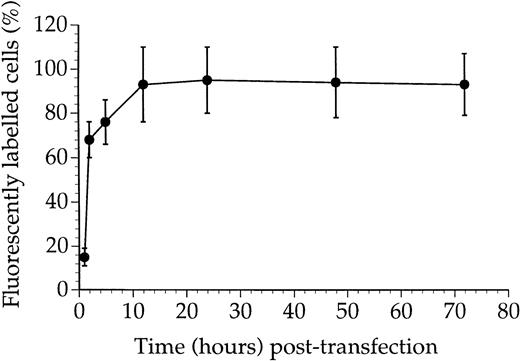
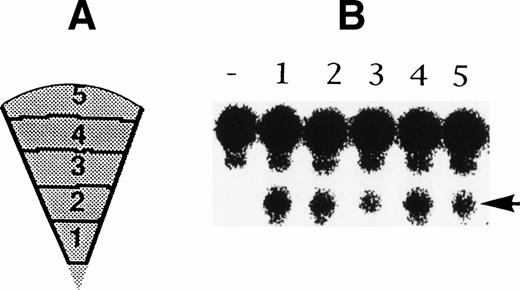
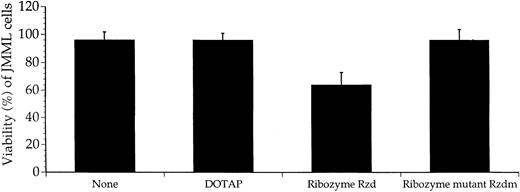
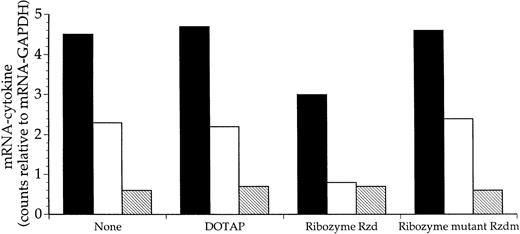

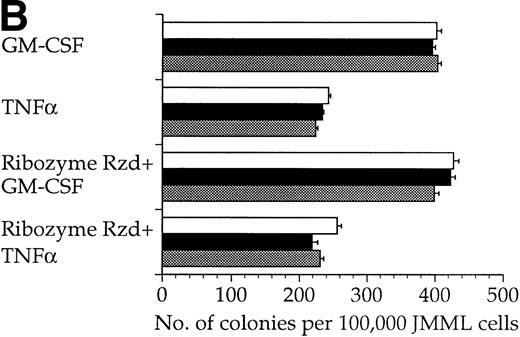
This feature is available to Subscribers Only
Sign In or Create an Account Close Modal